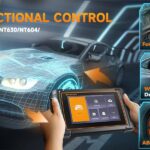Are you fascinated by the world of 3D printing and car modification? Imagine creating custom parts for your vehicle right in your own workshop. For car enthusiasts and DIYers, 3D printing opens up a realm of possibilities, allowing for the creation of unique and functional components. One such component, often overlooked yet easily customizable, is the Obd2 Cover.
The On-Board Diagnostics II (OBD2) port is a vital interface in modern vehicles, providing access to the car’s computer for diagnostics and data retrieval. While often hidden, the OBD2 port and its cover play a role in protecting this sensitive connection from dust, debris, and accidental damage. If your OBD2 cover is lost, broken, or you simply desire a personalized touch, 3D printing offers an excellent solution.
Why consider 3D printing an OBD2 cover? The benefits are numerous. Firstly, customization is key. You can design a cover that perfectly matches your car’s interior, add a logo, or even incorporate features like a tighter seal or a more robust design. Secondly, for older or less common vehicles, finding a replacement OBD2 cover can be challenging. 3D printing allows you to create a perfectly fitting replacement without scouring junkyards or dealerships. Finally, it’s a fantastic project for those looking to explore the capabilities of their 3D printers and delve into automotive DIY.
Selecting the right 3D printer for your OBD2 cover project is important. For general purpose and ease of use, a printer like the LulzBot Taz 6 is a great option, particularly for using PLA filament. PLA (Polylactic Acid) is known for its ease of printing and is suitable for parts like enclosures and covers that don’t require extreme heat resistance. It excels at creating parts with flat surfaces, making it ideal for an OBD2 cover that needs to sit flush against the dashboard. PLA is less prone to warping during printing, which is a common issue with ABS (Acrylonitrile Butadiene Styrene) when creating flat components.
Alt text: LulzBot Taz 6 3D printer expertly crafting a durable PLA component, showcasing its precision and reliability.
If you’re looking for a more versatile option that can handle different materials, including ABS, consider a printer similar in capability to the Makerbot Replicator 2X. While the original Replicator 2X may be discontinued, there are many clones and similar dual extruder printers available, such as those from FlashForge. ABS is a more durable and heat-resistant material than PLA, making it potentially suitable for an OBD2 cover that might be exposed to higher temperatures inside a car. However, ABS can be more challenging to print with, requiring a heated bed and enclosure to prevent warping.
Alt text: FlashForge 3D printer skillfully manufacturing a robust ABS component, highlighting its capacity for durable and heat-resistant materials.
For projects demanding exceptional detail and a smooth finish, although perhaps overkill for an OBD2 cover, SLA (Stereolithography) printers like the Formlabs Form 2 offer unparalleled precision. SLA printers use resin and are capable of producing parts with incredibly fine details. While typically more expensive and slower for larger prints, an SLA printer could be used to create a highly refined OBD2 cover with intricate designs or lettering if desired.
Alt text: Formlabs Form 2 SLA 3D printer generating a highly detailed resin print, demonstrating its capability for intricate and smooth surface finishes.
Designing your OBD2 cover is the next step. User-friendly CAD (Computer-Aided Design) software like Tinkercad (free and web-based) or Fusion 360 (more advanced, but free for personal use) can be used to create your 3D model. You’ll need to take accurate measurements of your OBD2 port to ensure a snug fit. Consider adding features like a small lip for easy removal or ventilation holes if desired. Online repositories like Thingiverse are also excellent resources for pre-designed OBD2 cover models that you can download and print directly or modify to your liking.
Once your design is finalized and you’ve chosen your 3D printer and material, the printing process can begin. Depending on the size and complexity of your OBD2 cover, printing time can range from under an hour to a few hours. After printing, some minor post-processing, such as removing support structures and sanding any rough edges, might be necessary to achieve a smooth and finished look.
In conclusion, 3D printing an OBD2 cover is a rewarding and practical DIY project for car enthusiasts. It allows for customization, provides solutions for hard-to-find parts, and is an excellent way to engage with the maker community and the exciting world of 3D printing. Whether you opt for the ease of PLA on a printer like the LulzBot Taz 6 or explore the versatility of ABS on a printer similar to the Makerbot Replicator 2X, creating your own OBD2 cover is a tangible way to personalize your vehicle and experience the power of digital fabrication.

